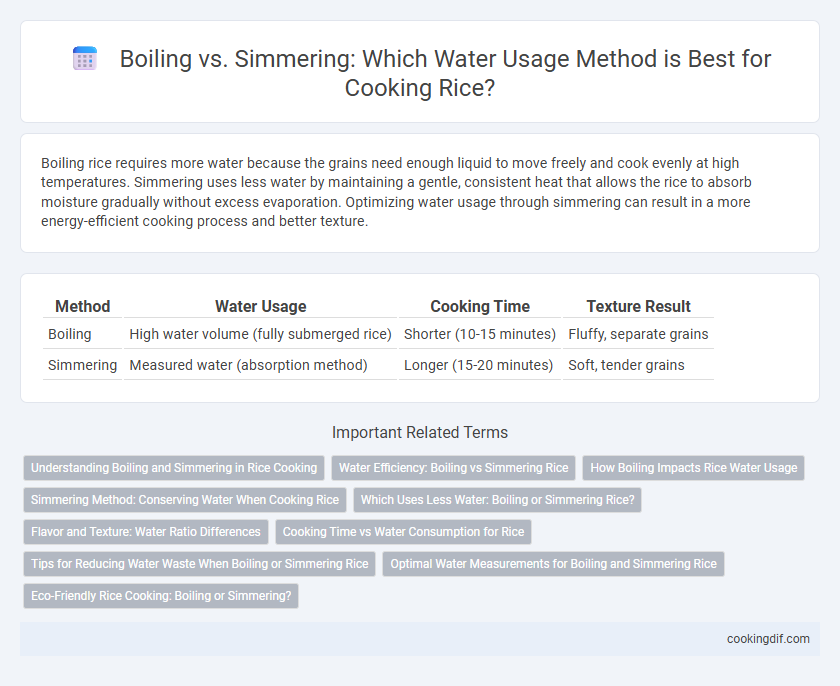Boiling rice requires more water because the grains need enough liquid to move freely and cook evenly at high temperatures. Simmering uses less water by maintaining a gentle, consistent heat that allows the rice to absorb moisture gradually without excess evaporation. Optimizing water usage through simmering can result in a more energy-efficient cooking process and better texture.
Table of Comparison
| Method | Water Usage | Cooking Time | Texture Result |
|---|---|---|---|
| Boiling | High water volume (fully submerged rice) | Shorter (10-15 minutes) | Fluffy, separate grains |
| Simmering | Measured water (absorption method) | Longer (15-20 minutes) | Soft, tender grains |
Understanding Boiling and Simmering in Rice Cooking
Boiling involves heating water to 212degF (100degC), producing vigorous bubbles that rapidly cook rice but can cause grain breakage and loss of nutrients. Simmering maintains water temperatures between 185degF and 205degF, allowing gentle heat that ensures evenly cooked, fluffy rice with better texture retention and nutrient preservation. Understanding these temperature differences helps optimize water usage and cooking efficiency for perfect rice results.
Water Efficiency: Boiling vs Simmering Rice
Boiling rice requires a higher volume of water to ensure fully cooked grains, often leading to excess water being drained and wasted, whereas simmering uses a controlled, lower amount of water that allows absorption, significantly reducing water waste. Simmering rice maximizes water efficiency by enabling the grains to absorb almost all the cooking water, resulting in minimal water runoff and less environmental impact. Choosing simmering over boiling conserves water resources and aligns with sustainable cooking practices, especially in regions experiencing water scarcity.
How Boiling Impacts Rice Water Usage
Boiling rice consumes more water as the rice grains absorb water rapidly at high temperatures, causing them to swell and release starch. This process often requires draining excess water, leading to higher water usage compared to methods like simmering. Simmering allows the rice to cook slowly, minimizing water waste by enabling complete absorption without overflow.
Simmering Method: Conserving Water When Cooking Rice
Simmering rice uses less water compared to boiling because it requires only enough water to be absorbed by the rice, minimizing excess water waste. This method enhances water conservation by reducing evaporation and runoff during cooking. Cooking rice through simmering not only preserves water but also maintains optimal texture and nutrient retention.
Which Uses Less Water: Boiling or Simmering Rice?
Simmering rice uses less water than boiling because it requires a lower water-to-rice ratio and less evaporation during cooking. Boiling demands more water to fully immerse the rice and maintain a rapid boil, leading to greater water loss through steam. Choosing simmering over boiling optimizes water efficiency while ensuring proper rice texture.
Flavor and Texture: Water Ratio Differences
Boiling rice uses a higher water-to-rice ratio, causing the grains to absorb more water quickly, often resulting in softer, sometimes mushier texture with less concentrated flavor. Simmering employs a lower water ratio with gentle heat, allowing rice to cook evenly while preserving firmness and enhancing the natural starches that contribute to a richer, more distinct taste. Adjusting water ratios between boiling and simmering directly impacts the final rice texture and flavor intensity, making simmering ideal for fluffy, flavorful grains.
Cooking Time vs Water Consumption for Rice
Boiling rice requires a higher amount of water and a shorter cooking time, typically around 10-15 minutes, which can lead to increased water consumption. Simmering uses less water by maintaining a gentle heat, extending the cooking time to 18-25 minutes but optimizing water retention and absorption within the rice grains. This balance in simmering results in more efficient water use during cooking, reducing waste compared to boiling.
Tips for Reducing Water Waste When Boiling or Simmering Rice
Using just enough water to cover the rice during boiling minimizes excess water waste, while simmering on low heat prevents unnecessary evaporation. Covering the pot with a tight-fitting lid retains steam, reducing the need for added water and speeding up cooking time. Reusing leftover hot water for other kitchen tasks, like watering plants, enhances overall water efficiency in rice preparation.
Optimal Water Measurements for Boiling and Simmering Rice
Optimal water measurements for boiling rice typically require a higher water-to-rice ratio, such as 4 cups of water per 1 cup of rice, to allow vigorous boiling without drying out. Simmering rice uses a lower water-to-rice ratio, around 2 cups of water per 1 cup of rice, maintaining gentle heat to absorb moisture evenly and prevent mushiness. Precise water usage during boiling and simmering directly impacts rice texture and cooking efficiency, ensuring fluffy grains with proper hydration.
Eco-Friendly Rice Cooking: Boiling or Simmering?
Simmering rice uses less water and energy compared to boiling, making it a more eco-friendly cooking method by reducing water waste and energy consumption. Boiling often requires more water that is later drained, increasing water usage and environmental impact. Choosing simmering helps conserve resources while preserving rice texture and flavor efficiently.
Boiling vs Simmering for water usage Infographic

 cookingdif.com
cookingdif.com